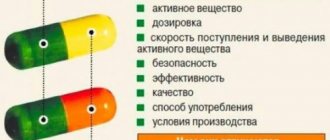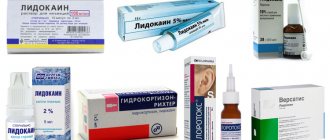Compound
| Syrup | 10 ml |
| active substances: | |
| salbutamol sulfate (equivalent to salbutamol) | 2 mg |
| Bromhexine hydrochloride | 4 mg |
| guaifenesin | 100 mg |
| excipients: sucrose (sugar); sorbitol (70% solution); glycerol (glycerol); propylene glycol; sodium benzoate; citric acid monohydrate; sorbic acid; dye “Sunset” yellow (FCF); menthol (levomenthol); blackcurrant flavor (blackcurrant flavor ID20158); pineapple flavor (pineapple flavor super “PH”); purified water |
Composition and release form
For 10 ml of syrup:
- Active ingredients: salbutamol sulfate, equivalent to salbutamol - 2.00 mg, bromhexine hydrochloride - 4.00 mg, guaifenesin - 100.00 mg;
- Excipients: sucrose (sugar), sorbitol (70% solution), glycerol (glycerin), propylene glycol, sodium benzoate, citric acid monohydrate, sorbic acid, sunset yellow (FCF), menthol (levomenthol), blackcurrant flavor (black fragrance currant ID 20158), pineapple flavor (pineapple flavor super “PH”), purified water.
100 ml or 200 ml in a dark plastic bottle with a screw-on aluminum cap with tamper evident, on which a white plastic measuring cap or a transparent plastic measuring cap with the “G” logo and multi-colored marks is fixed (green for 2.5 ml, yellow for 5.0 ml and red for 10.0ml). One bottle along with instructions for use is placed in a cardboard box.
Pharmacodynamics
The combined drug has a bronchodilator, expectorant and mucolytic effect.
Salbutamol is a bronchodilator that stimulates beta2-adrenergic receptors of the bronchi, blood vessels and myometrium. Prevents or eliminates bronchospasm, reduces resistance in the respiratory tract, increases the vital capacity of the lungs. Causes expansion of the coronary arteries, does not reduce blood pressure.
Bromhexine is a mucolytic agent. Has an expectorant effect, improves sputum discharge.
Guaifenesin is a mucolytic agent that reduces the surface tension of the structures of the bronchopulmonary apparatus; stimulates secretory cells of the bronchial mucosa that produce neutral polysaccharides, depolymerizes acidic mucopolysaccharides, reduces the viscosity of sputum, facilitates the removal of sputum and promotes the transition of a non-productive cough to a productive one.
Contraindications
- hypersensitivity to the active and auxiliary substances of the drug;
- simultaneous use of antitussives, non-selective β-adrenergic receptor blockers, monoamine oxidase inhibitors, cardiac glycosides;
- tachycardia, myocarditis, heart defects;
- peptic ulcer of the stomach and duodenum (in the acute stage);
- stomach bleeding;
- hyperthyroidism;
- glaucoma;
- hereditary fructose intolerance, glucose-galactose malabsorption syndrome, sucrase-isomaltase deficiency;
- decompensated diabetes mellitus;
- liver and/or kidney failure;
- pregnancy, lactation period;
- children up to 2 years old.
Pharmacokinetics
Salbutamol
When taken orally, absorption is high. Eating reduces the rate of absorption but does not affect bioavailability. Communication with plasma proteins - 10%. Penetrates through the placenta. Subjected to first-pass metabolism in the liver and intestinal wall, it is inactivated by phenol sulfotransferase to 4-o-sulfate ester. T1/2 - 3.8–6 hours. Excreted by the kidneys (69–90%), mainly in the form of an inactive phenol sulfate metabolite (60%) within 72 hours and with bile (4%). The bioavailability of orally administered salbutamol is about 50%.
Bromhexine
When taken orally, it is almost completely (99%) absorbed into the gastrointestinal tract within 30 minutes. Bioavailability is low (first pass effect through the liver). Penetrates through the placental barrier and BBB. In the liver it undergoes demethylation and oxidation, metabolized to the pharmacologically active ambroxol. T1/2 - 15 hours (due to slow reverse diffusion from tissues). Excreted by the kidneys. With chronic renal failure, the excretion of metabolites is impaired. May accumulate with repeated use.
Guaifenesin
Absorption from the gastrointestinal tract is rapid (25–30 minutes after oral administration). T1/2 - 1 hour. Penetrates tissues containing acidic mucopolysaccharides. Approximately 60% of the administered drug is metabolized in the liver. It is excreted by the lungs (with sputum) and the kidneys both unchanged and in the form of inactive metabolites.
special instructions
It is not recommended to use the drug Ascoril expectorant simultaneously with non-selective β-adrenergic receptor blockers, such as propranolol.
The expectorant salbutamol, which is part of the drug Ascoril, is not recommended for patients receiving monoamine oxidase inhibitors (MAOIs).
It is not recommended to take an alkaline drink simultaneously with Ascoril expectorant.
Carefully
- Diabetes.
- Arterial hypertension.
- Peptic ulcer of the stomach and duodenum is in remission.
Use during pregnancy and lactation
The drug is contraindicated during pregnancy and lactation.
Interaction with alcohol
Information on interaction with ethanol is not provided.
Impact on the ability to drive vehicles and other mechanical means
Information on the effect of Ascoril expectorant on the ability to drive vehicles and other mechanical means is not provided.
Interaction
Other beta2-adrenergic agonists and theophylline enhance the effect of salbutamol and increase the likelihood of side effects.
Ascoril expectorant is not prescribed simultaneously with drugs containing codeine and other antitussives, because this makes it difficult to clear liquefied sputum.
Bromhexine, which is part of the drug, promotes the penetration of antibiotics (erythromycin, cephalexin, oxytetracycline) into the lung tissue.
It is not recommended to use the drug simultaneously with non-selective beta-adrenergic blockers such as propranolol.
Salbutamol, which is part of the drug, is not recommended for patients receiving MAO inhibitors.
Diuretics and corticosteroids enhance the hypokalemic effect of salbutamol.
It is not recommended to take alkaline drinks simultaneously with the drug Ascoril expectorant.
Ascoril
Release form
Pills. White, round, flat tablets with a bevel and a one-sided score.
Compound
Active ingredients : bromhexine hydrochloride (8 mg); guaifenesin (100 mg); salbutamol sulfate (equivalent to salbutamol, 2 mg).
Excipients : calcium hydrogen phosphate; corn starch; methyl parahydroxybenzoate (methylparaben); propyl parahydroxybenzoate (propylparaben); purified talc; colloidal silicon dioxide; magnesium stearate.
Pharmacological group
A drug with mucolytic, expectorant and bronchodilator effects, a combined expectorant
Action
Mucolytic, expectorant, bronchodilator.
Bromhexine is a mucolytic agent that has an expectorant effect. Increases the serous component of bronchial secretions; activates the cilia of the ciliated epithelium, reduces the viscosity of sputum, increases its volume and improves discharge.
Bromhexine - description of the substance
Guaifenesin is a mucolytic agent that reduces the surface tension of the structures of the bronchopulmonary apparatus; stimulates secretory cells of the bronchial mucosa that produce neutral polysaccharides, depolymerizes acidic mucopolysaccharides, reduces the viscosity of sputum, activates the ciliary apparatus of the bronchi, facilitates the removal of sputum and promotes the transition of an unproductive cough to a productive one.
Salbutamol is a bronchodilator that stimulates beta2-adrenergic receptors of the bronchi, blood vessels and myometrium. Prevents or eliminates bronchospasm, reduces resistance in the respiratory tract, increases the vital capacity of the lungs. Causes expansion of the coronary arteries, does not reduce blood pressure.
Indications
As part of combination therapy for acute and chronic bronchopulmonary diseases, accompanied by the formation of a difficult to separate viscous secretion:
- bronchial asthma;
- tracheobronchitis;
- obstructive bronchitis;
- pneumonia;
- emphysema;
- whooping cough;
- pneumoconiosis;
- pulmonary tuberculosis.
Contraindications and restrictions
- Hypersensitivity to the components of the drug;
- tachyarrhythmia, myocarditis;
- heart defects;
- decompensated diabetes mellitus;
- thyrotoxicosis;
- glaucoma;
- liver or kidney failure;
- peptic ulcer of the stomach and duodenum in the acute stage;
- stomach bleeding;
- arterial hypertension;
- pregnancy;
- lactation period;
- children under 6 years of age.
with caution to patients with diabetes mellitus, gastric and duodenal ulcers in remission.
during pregnancy . If treatment with the drug is necessary during lactation, breastfeeding should be discontinued.
Application and dosage
Inside, 3 times a day.
- Adults and children over 12 years old - 1 tablet each;
- children from 6 to 12 years old - 1/2 or 1 tablet;
- Children under 6 years of age are recommended to use Ascoril Expectorant syrup.
Side effect
From the immune system: rarely - hypersensitivity reactions; frequency unknown - anaphylactic reactions, including anaphylactic shock, angioedema and itching.
From the side of the central nervous system: rarely - headache, dizziness, increased nervous excitability, sleep disturbance, drowsiness, tremor, convulsions.
From the cardiovascular system: rarely - rapid heartbeat, collapse.
From the respiratory system, chest and mediastinal organs: rarely - bronchospasm.
From the gastrointestinal tract: rarely - nausea, vomiting, diarrhea, exacerbation of gastric and duodenal ulcers.
From the kidneys and urinary system: rarely - urine may turn pink.
From the skin and subcutaneous tissues: rarely - rash, urticaria; frequency unknown - severe skin adverse reactions (including erythema multiforme, Stevens-Johnson syndrome, toxic epidermal necrolysis and acute generalized exanthematous pustulosis associated with the use of ambroxol (ambroxol is a metabolite of bromhexine).
Overdose
Symptoms: increased side effects. Treatment: symptomatic therapy.
special instructions
There have been reports of severe skin reactions such as erythema multiforme, Stevens-Johnson syndrome, toxic epidermal necrolysis and acute generalized exanthematous pustulosis associated with the use of ambroxol. Since ambroxol is a metabolite of bromhexine, the risk of anaphylactic and severe skin reactions may also be considered for bromhexine.
If symptoms of a progressive skin reaction occur (sometimes associated with damage to the mucous membranes of the mouth, throat, nose, eyes, genitals), you should immediately stop using the drug Ascoril and consult a doctor.
Guaifenesin turns urine pink.
Drug interactions
- It is not recommended to take alkaline drinks at the same time as the drug.
- Other beta2-adrenergic agonists and theophylline enhance the effect of salbutamol and increase the likelihood of side effects.
- Ascoril is not prescribed simultaneously with drugs containing codeine and other antitussives, because this makes it difficult to clear liquefied sputum.
- Bromhexine, which is part of the drug Ascoril, promotes the penetration of antibiotics (erythromycin, cephalexin, oxytetracycline) into the lung tissue.
- It is not recommended to use Ascoril simultaneously with non-selective beta-adrenergic blockers, such as propranolol.
- Salbutamol, which is part of the drug Ascoril, is not recommended for patients receiving MAO inhibitors.
- Diuretics and corticosteroids enhance the hypokalemic effect of salbutamol.
Storage
Store out of the reach of children at room temperature no higher than 25°C. Shelf life: 2 years.
Production
Glenmark Pharmaceuticals Ltd (India)
Package
10 pieces. in cellular contour packaging. 1, 2 or 5 packages in a cardboard box.
Recipe
Available without a prescription.


